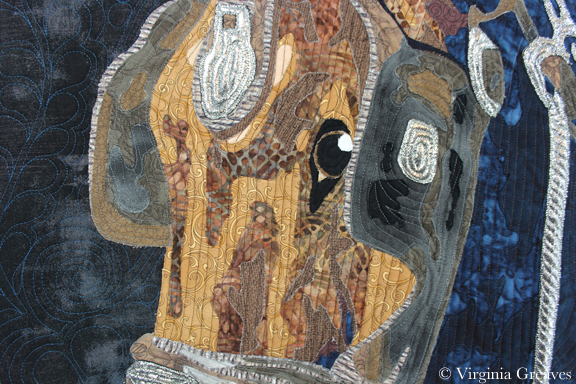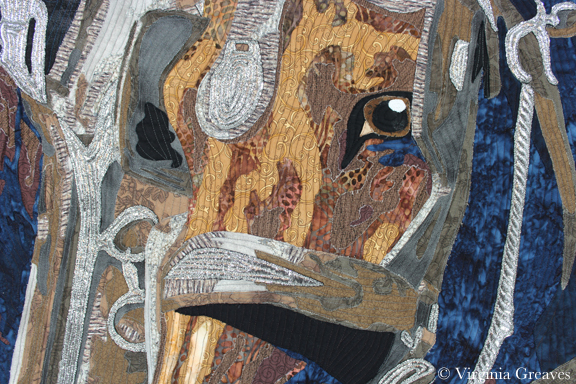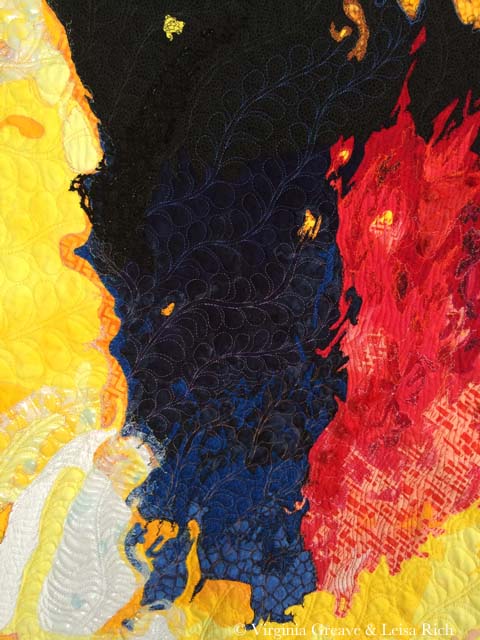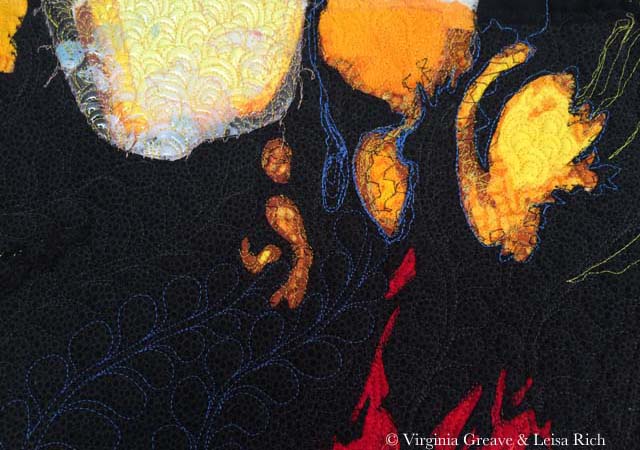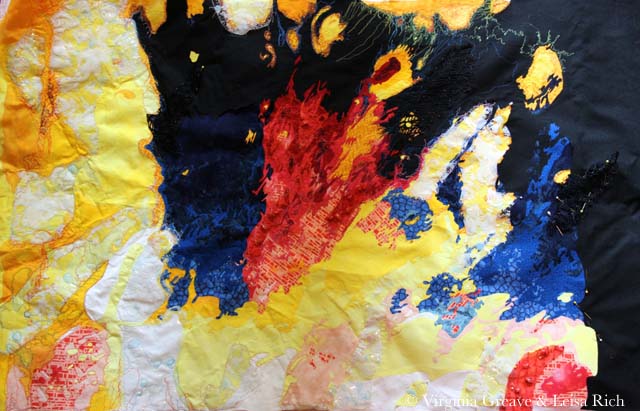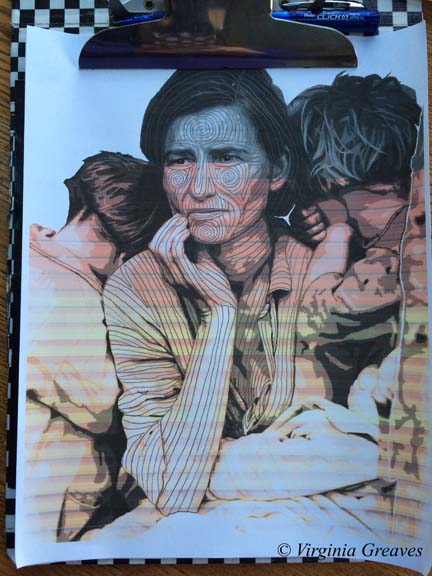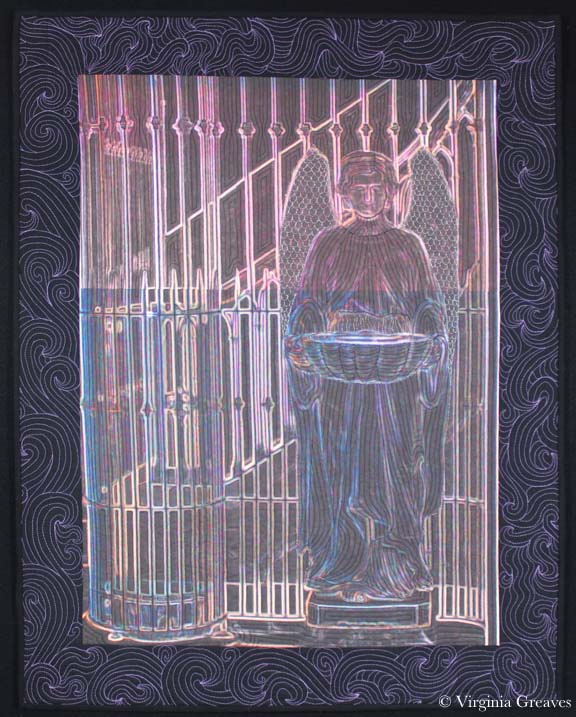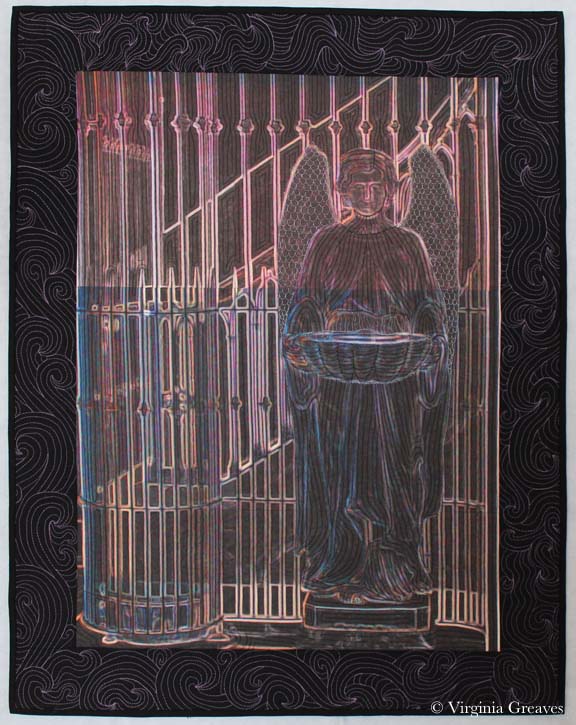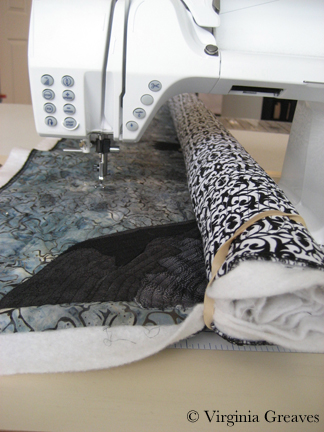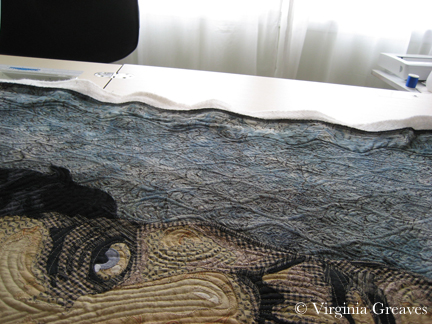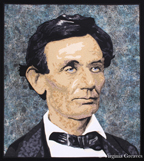Quilting
Quilting

What’s in a Name
5I have finally completed the horses. I spent almost 137 hours on them. The bulk of that time was cutting and fusing, which was over 63 hours, and then I spend almost 30 hours quilting it.
As noted before, I used my home machine, a Janome 7700. I just set up extra tables all the way around to hold the weight of it as I quilted it. I also practiced drawing my background design from all angles so I wouldn’t have to move the quilt around as much.
This is detail of the first horse on the left — shows some of the intricate background quilting.
This is detail of the second horse on the right.
And now I’m faced with naming this piece. When I hear the song Renegades by X Ambassadors, that feels about right. To me, the horses are renegades in the sense that they’re rebellious and unconventional. However, if you look up the definition of renegade, it’s a traitor or deserter — which isn’t right at all.
They are military horses used in cavalry, and Calvary might make a good name — or War Horses.
If you have an opinion on a name, please leave a comment. I would love to have some input.

How to Eat an Elephant
5Often, I wonder what to name a blog post — but not this one. At first, I was going to title it, Nothing is Ever Easy. That’s what I had in my head as I started this morning, but it quickly turned into How to Eat an Elephant.
My Elephant is the Horses. I have been holding off quilting it until I took a long-arming class at my local quilt shop. I had it in my head that, because of its size, I had to put it on a frame. So I worked on every other project in my house while I waited for my class, which I had last Saturday — except it wasn’t what I thought it would be.
I was very lucky to be given the chance to sew on four different HandiQuilter long-arm machines. The 1st was the Sweet 16 which was set into a table. I was sure that this was NOT the one for me. The next model up was the Simply 16 on a small frame, then the Avante on a full sized frame, and finally the Fusion on the largest frame. I had my eye on the Avante.
There were three other people in my class, so we rotated through the machines. I started with the Simply 16 on the smallest frame. Although I don’t normally quilt a lot of feathers, I decided that it was a good place to start. I was so surprised that I couldn’t make the petals come back to the stem. It was really hard to control. And then I worked on the Avante, and it was better, but not a lot. The machine was not moving as I wanted it to. The teacher suggested that I was too used to free motion quilting with my hands guiding the piece, rather than guiding the machine over the top of the quilt. Then I tried a pantograph on the Fusion. I’m not the least bit interested in pantographs, but it seemed to be the highlight of the class to everyone else, and it was a good exercise to just follow a drawn line. It was hard to do too.
And then I sat down at the Sweet 16, and I just quilted. It felt natural, and my feathers looked great. I was in control.
<sigh> I knew by the end that there was no way that I could put the horses on a frame. It’s possible for me to develop the skill over time, but it’s not something that’s going to happen quickly. Renting by the hour at the local shop, I don’t know that it will ever happen. The skill set that I’ve developed is just not as translatable to a frame as I wanted (& needed) it to be.
So I came home and knew that I was going to spray baste my quilt and start quilting it here at home. I may take it to the shop towards the end, when it’s at its heaviest, when I’m quilting the background, and see if the Sweet 16 is a big improvement over quilting it at home, but the table, even with the extra side pieces, is not very big. Here at home, I’ll set up many tables around my machine, and although I’ll have to crawl on the floor to get out of my studio, hopefully it’ll hold the length of the quilt as I’m working on it so gravity won’t be working against me.
And today, I laid out my sheet in the kitchen, I taped things down, and I started spraying. I do wish that I had put down a second sheet as I had quite a bit of overspray onto my wooden floor. My poor socks are covered in a layer of spray glue. But it’s done. My back hurts, but it’s basted.
At least there was no one here to laugh at me as I crawled around on the floor, smoothing it out.
When I was done, I took it upstairs and made sure the back and front were perfectly smooth. I always find that, even with taping, I have a few lumps and wrinkles that need to be worked out. Thank goodness the spray basting allows me to reposition everything until it’s smooth.
Now it’s ready for quilting. Wish me luck. I think I might need it.

More Pics Please!
0A friend told me that it was hard to see what I had done on the piece from my last blog post so I have posted some more detail pics. I hope this makes it easier to see the quilting.

Quilting as Another Dimension
1Yesterday I finally finished quilting the 3rd abstract piece that I’ve been working on collaboratively with Leisa Rich. I have to admit that I let my mind run away with this one.
This is a pic that Leisa took of it after she had added embroidery.
And this is the same piece after I have quilted it.
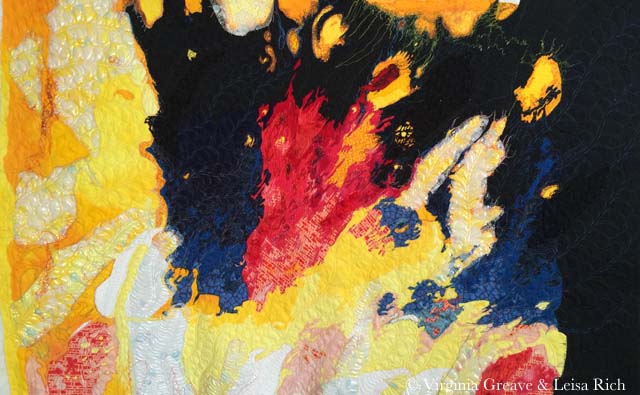
I started with free motion quilted feathers — in metallic thread. CRAZY if you’ve ever sewn with metallic copper thread — but I had the wind at my back that day and it flowed like water onto the surface of the piece. I graduated through copper, purple, blue, and then a gray for the deepest part of the black fabric. I then moved over to the red and brought a flame stitch out of my bag of tricks. Then I moved down into the yellows and whites. I did change to more of a wavy frond for the white — I liked the difference in texture — and some of the yellow blobs were awarded with scallops. I did revisit the copper thread on the lighter blue fabric over on the right hand side — but I was not lucky on those days and struggled with a lot of broken thread. I moved back into blue thread as soon as the piece was ready for a change.
I love free motion quilting on my Janome. Even sewing on the plastic overlay didn’t cause many problems. My Viking would have given me fits.
I hope Leisa forgives me for putting traditional feathers all over it. It called out for that organic feeling. I’ve never used so many free flowing feathers on a piece in my life. It felt good to step out of contour quilting.
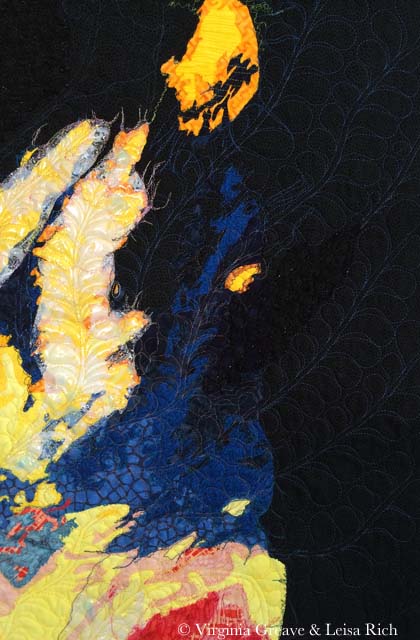 I am giving this back to Leisa next week — I think she’s planning some hand embellishment.
I am giving this back to Leisa next week — I think she’s planning some hand embellishment.
We have a curator that approached a local Atlanta gallery about having a two person show of our work — and it looks like we have reached an agreement and the show will go on in late 2015. Time to get busy — I have a lot to do to get ready!

New Solutions
0Last week, I completed the 1st and 2nd pieces in the collaborative series. I did the 2nd one first — the larger one — and all of the binding was done by hand. The 1st one — the smaller one — I couldn’t bear to hand stitch the binding. I had too many holes in my hands. I just couldn’t do — so I did something I’ve only done once before. I machine stitched the binding.
I drew out the outline of the final boundaries on the top. Then I stitched on top of that outline using a yellow bobbin. Then I turned it over and used the yellow line to show me where to machine apply the binding. Once it was on (and the top edge of the sleeve), I cut off the excess.
There is a lot of plastic on the top of this one so I had to be very careful with this next step. I love using Sharon Schamber’s trick to hold the binding in place with water soluble clear Elmer’s glue that has been pressed with an iron — but doing this meant folding the binding to the top and pressing right next to the plastic without melting it with my iron. It had to be hot enough to engage the glue to hold — but not hot enough to melt the plastic underneath. I was “pressing” my luck but I did it anyway and it worked well enough. I then used a machine blanket stitch to attach the binding to the front.
I’ve been surprised over the years that — the only other quilt I’ve done this with — I have hanging in my living room and I truly forget that the binding was attached differently. Looking at it very closely, I prefer it the other way. If the final stitches are on the back, any irregularities are on the back — but my hands had to have some time to heal. I think it turned out fine. I still had to hand stitch the sides and bottom of the sleeve and the corners of the quilt — but there wasn’t a lot of that.
My typical process after finishing a piece is to block it, photograph it, and then post a new page for it on my website. Leisa and I both agreed not to completely block these pieces — although I did spray the binding with water and, on the small one, I pinned it to the ironing board and soaked the binding only in an effort to make the piece hang straight.
I photographed the 2nd one with no issues. The 1st one cannot be photographed using my traditional methods — the plastic across the front on top of the black causes too big of a glare. After spending time reading about this, I think I’m going to have to built a light diffusion box just for the purposes of getting a good picture — so there is a future project.
Leisa has asked that we not debut the final pieces until they are exhibited all together in (hopefully) late 2015. Therefore I will post pages for them without final pictures — only a notice of exhibition. This was a hard decision for me but I agree that seeing all of the pieces together creates an impact that would be diminished by individual publication.
I have been thinking about a portrait for competition — what needs to be my next piece — but I’m still in the idea stage so I started prepping #3 for quilting yesterday. Like #1, it has plastic on it — so it can’t be pin basted — my usual method. It would have to be spray basted — but it’s quite a bit larger than #1 so I jumped on the internet for some help and came up with the following plan.
First, I laid down a sheet on the wooden floor in my kitchen. (Yes I know it’s hideous — it was bought years ago for one of my girls. Makes it perfect for this.) I taped down the edges. The intent is for this to catch all of the overspray. When I’m done, I can just throw it in the laundry.
Then I tape the backing fabric face down onto the sheet.
And then I lay the batting on top of the backing.
I fold half of it back . . .
and I grab this can of 505 Spray and spray the BATTING that’s been folded back. I then fold it back onto the backing making sure that it’s smooth. If there is a wrinkle, I can lift it, move it, and then press it back together. Then I do the same thing with the other side. I fold the batting over at the halfway mark, spray it, and then smooth it back onto the backing fabric.
Once that’s done, I do the exact same thing with the top — except I still spray the BATTING.
It took me half an hour to do this, and at the end, my fingers didn’t hurt. I was at the end of a can and it started spraying out white goo — which thankfully didn’t transfer to the quilt. It just stuck to the can. I luckily had another full can to finish the job.
I should consider doing it this way more often. Even better, I realized this morning that I can draw out some intricate shapes on the top this morning without worrying about pins getting in my way. I know you’re supposed to do all of your drawing (if you’re going to do that) before you baste it, but my process is more organic. I add to the piece what it needs as I go along.

Quilting Gadgets
0Having finally finished the appliqué for the family portrait I’ve been working on, I pinned the piece with batting and backing — and then began to prepare myself mentally to begin quilting.
This is always the hardest part for me. I will put it off and find a hundred excuses not to get started. I think that the fear stems from the dislike of UN-sewing — an inevitability of the quilting process. I have, however, discovered that a good way to move me through this stage and get back to the machine is to print off the value painting I made earlier and start drawing quilting ideas on it. If I don’t like the direction of a particular area, all I have to do is erase it. Then when I sit at my machine, the drawing sits beside me and tells me where I need to go.
(Forgive the print — it came out in a pinkish hue because I was running out of black ink.)
I did have a problem when I sat down at my machine though. I have a Viking Designer 1 — and the truth of the matter is that it has given me problems since year 4 (it’s about 13 years old now). I had taken it in to the dealer for a cleaning — and she kept it for MONTHS (did I mention I didn’t have a backup machine?) — and when I FINALLY got it back, the touch screen menu didn’t always do what it was supposed to do. I could always reset it by turning it off and on — and I certainly didn’t want THAT dealer to touch it again (and Viking wouldn’t let me use anyone else) — so I had to wait until sometime after year 5 after she had gone out of business before I let someone look at it again (I still have trust issues with someone having my machine for any length of time).
I thought when I bought it that it was warranted for 20 years — and I considered it a good 20 year investment piece. However, I learned the hard way that the electronics were only covered for 5 years. And did I mention that the cost of replacing the motherboard is about $1,200?
Anyway, I’ve just lived with it — but when I sat down on Thursday to start quilting, it just wouldn’t behave. However, I have another Designer 1 that a friend gave me years ago (after hearing me complain about mine — she thought hers would be kinder to me) — so I took everything and set it up on that machine. I turned it on — and learned that it had grown unhappy over the last few months — watching me sew away on my other machine. That machine’s screen doesn’t work — at all. Not even a little.
I went back to my original machine and finally got it back in business. (And since then, it’s been working really well. It must know that I’ve been looking at other machines on the internet.)
And why all of this drama? Well — I have to come clean here. The truth is that I’ve been quilting with my feed dogs up for years. I KNOW! Crazy as it sounds, when I was first starting out, I was having problems and someone suggested just leaving them up — so I did and it helped and it’s been that way ever since.
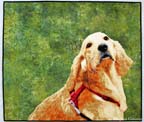 Except when I was quilting my last piece, Golden Moment, it was sooooo heavy and it was hard to move around — so I was persuaded to try Leah Day‘s Ultimate Quilting Kit — a Supreme Slider, Machinger gloves, and Little Genie teflon bobbin washers.
Except when I was quilting my last piece, Golden Moment, it was sooooo heavy and it was hard to move around — so I was persuaded to try Leah Day‘s Ultimate Quilting Kit — a Supreme Slider, Machinger gloves, and Little Genie teflon bobbin washers.
By the time the set came, I had just finished quilting — but I knew the day would come that I’d really enjoy using them — and that day was Thursday.
Except — in order to use the Supreme Slider, the feed dogs have to be down. You don’t want it to accidentally slide out of position (which the feed dogs might do) and start being quilted to the underside of your piece. That would be REALLY bad.
Hence the sewing machine problems. I had lowered the feed dogs to set up the machine only to realize I had a couple of appliqué fixes to make — so I had to raise the feed dogs — which they didn’t want to do.
The sewing machine argument aside — I enjoyed the gadgets. The teflon washer that you drop in the bobbin case really does cut down on the out of control speed spinning that the bobbin can sometimes do when you’re quilting fast. The Machinger gloves help me hold onto the quilt — but they’re going to take some getting used to. (It’s awkward when I have to start a new line and pull the bottom thread to the top with the gloves on — I end up with a lot more thread pulled than I’m used to.) The Slider also helps move the quilt around easily — although I’ll be able to evaluate the drag on the needle better when I get to the edges of the quilt. (I started quilting in the middle which keeps most of the quilt on the table so there’s not much drag at this point.)
Quilting with the feed dogs down does feel a lot different — I can tell that I have a higher chance of messing up the intentionality of the line if I’m not extra careful. I might try decreasing the presser foot tension the next time I sit at the machine.
There’s a learning curve in everything new — but I think that these are good things to learn.
Today, I managed to finish quilting the mom in my piece — except for her hair and clothes.
I am worried about my sewing machine. I don’t know that I’ll ever want to buy another Viking given the customer service problems I’ve had with them — but nor do I relish the thought of learning an entirely new machine.
My friend Rebecca has a Janome 5500 that I may borrow for a while — so I can try another something new.

Completing the Raven
0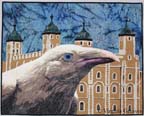 I have finally completed The White Raven. The bird was wonderful — the Tower of London was tedious — but I think in the end that it all came together. It’s ironic that I now have such a creative flow while constructing portraits and my more difficult moments are in the backgrounds.
I have finally completed The White Raven. The bird was wonderful — the Tower of London was tedious — but I think in the end that it all came together. It’s ironic that I now have such a creative flow while constructing portraits and my more difficult moments are in the backgrounds.
I used a stacking type of stitch while quilting the raven to give the impression of feathers — it was interesting to see how the white thread changed the character of the darker fabric shades. I am becoming completely reliant on Isacord thread for free motion quilting. I can run my machine at a high speed and the thread is less likely to shred. It’s also available in a huge selection of colors. A thread run before I start quilting is almost a must for me at this point.
The Tower was not as much continuous line quilting as I would have liked. There was a lot of stopping and starting — so it took much longer to do — but hopefully I’ve created the impression of the Tower in a minimalist way. I still wanted the focus to be on the raven.
The background was also difficult because of the Tower peaks. I started in the middle between two towers and echo stitched a wavy line upwards — but once I reached the top, I attempted to echo stitch back down between another set of towers. Any quilter knows that you have to quilt from the inside out — especially if you’re quilting densely. By quilting from a less dense to a more dense area, I created some ripples that could only be resolved by ripping out all of my quilting and starting over in the correct direction — from the more dense outwards to the less dense area.
 At the end, after I had washed it, blocked it, and added the label, I went back and added more quilting in the raven’s eye. It’s the focus of the piece and it did not have enough quilting relative to what was around it. I didn’t want it to sag over time.
At the end, after I had washed it, blocked it, and added the label, I went back and added more quilting in the raven’s eye. It’s the focus of the piece and it did not have enough quilting relative to what was around it. I didn’t want it to sag over time.
The raven isn’t exactly like the original — I had to take liberties with the beak especially — but I think it is definitely reminiscent of the pictures of Mike Yip. His photographs of the white ravens in the Vancouver Islands are really wonderful.
Adding the Tower of London gave the piece whimsy — a story — which I think adds to the visual interest of the piece.
Enter the Angel
1Back in December, I created a small 5″x7″ piece called The Dark Angel. As I’ve mentioned before, I loved it so much that I decided to use that as a study and create a larger piece based on that image. This is how I came to create The Bowl Judgments.
I do not usually add a border to my pieces but in this instance, I decided that a border could add another dimension to the piece. Just as the middle portion is about the luminosity of the colors on the black, I wanted the border to be the inverse. Using black fabric and a light purple thread, I created a subtle sweep of quilting lines.
I did, by the way, attempt the McTavish quilting technique on the borders. I probably got better as I went along. I suppose that the variance in the the quilting will just have to be chalked up to artistic variance.
I must admit that photographing his piece has been very difficult. My camera has not been happy and I have taken many pictures in an effort to create an image that accurately portrays how the piece looks.
At first, my camera locked up completely. As far as I can tell, it couldn’t tell where the image was — even in a room with special spotlights pointed at it. At some point, late in the day, it finally gave me something.
But really, this picture makes the border look almost like printed fabric. The quilting lines are more subtle and the image in the middle is not that washed out.
I finally realized that the camera would be happier if I used a white background. I thankfully had a large piece of white felt in my closet that I hung on my black design wall. From there, I set the autofocus point on the black border — and I think that this comes closest to the actual piece.
It always surprises me when the camera doesn’t just take a picture of what my eye can see. Our eyes are so much more complex than we give them credit for.
I so loved working on this angel that I would like to do another one — but I’ll have to plan some trips for pictures. Right now I’m researching another portrait to do but haven’t settled on an idea yet.

Quilting Lincoln
0I spent a long time quilting this piece. I took about a week to quilt his figure — but then I needed to do something for the background. I found that incorporating two different ideas gave me something workable without being overwhelming.
Like many people quilting on a domestic machine — I found some angles to be very challenging. My first design was a parallel flowing line which wasn’t too hard — but then I added swirls in the open spaces. These had to be done all in the same direction — so the left hand side of the quilt became a bear to manage. I found that rolling up the right hand side and holding it with rubber bands at the top and bottom gave me something to hold on to.
From this angle, you can see the background quilting better. I am so glad I took the time to add this texture to the piece. I think it adds to the feeling of age in it — and it’s a nice contrast to the contour lines on the face.
I think I’m slowing getting better at quilting. Although I’m not a huge proponent of the quilt police guidelines that the stitch length has to be perfectly consistent — and I do not have the luxury of a stitch regulator on my machine — over time, that is what is happening. I did not mark my design and chose instead to keep the framework of wavy lines organic — but even those became more uniform the more time I spent making them.
After a week of background quilting, I finally completed Lincoln. When I sat down to write my artist’s statement, I found it entirely too political, so I decided to merely include some of Lincoln’s quotes instead.
It feels good to finish before the holidays. I already have ideas for my next piece.

Me and Abe
3I am guilty of ignoring my blog. I took many pictures as I made his shirt, tie, coat, and finally his hair — but the progressions are not that interesting. The white doesn’t photograph well and the black — well I was overcome with black. Lincoln has a dour personage and although I didn’t intend this to be a dark piece, by nature of his hair and his clothing, there are a LOT of black prints in this piece.
This is how he looks on my black design wall. Not bad — but I thought he would look really good on a deep navy — something that would be lighter than his hair but still strong enough to evoke images of the Union flag. I even considered adding flag details in the background but decided that it would only distract from his piercing stare.
Clearly, I was wrong. It is hard to tell in the artificial lighting of most fabric stores how a value is really going to work. This one is much too dark. Sadly, I had been to a couple of local quilt stores, and this is the only one I felt had promise.
I found this sky fabric in my stash. It has a cool feel about it, almost as if Lincoln is standing on the battleground — but the white in the clouds is too distracting — another reason I finally declared that he needed a plainer background.
And then I found this green batik. It has a feeling of age to it. It has some texture in the print, but not much. It is exactly the right value. I wouldn’t have thought this would work — but there is some smoky blue in it that pulls out the color in his eyes — a faded gray that hopefully reflects weariness.
Today I’m pondering how to quilt him. I’ve been drawing on my picture of him. The lines of his face are so distinctive and different from what I’ve done before that I had to pull some new tricks out of my bag. The line under the left cheek for example had to be highlighted. The chin also sits in an awkward fashion and makes the joining of the cheek to the chin different from how I’ve approached it before.

